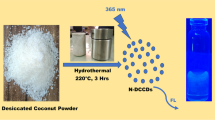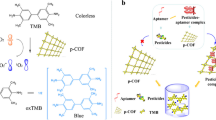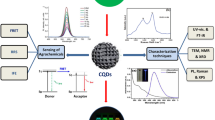Abstract
A novel fluorescent probe based on molecularly imprinted polymers (MIPs) coupled with carbon quantum dots (CQDs) was fabricated and successfully used for selective recognition of mesotrione. In this probe, the biomass-derived CQDs were prepared through a hydrothermal method using mango peels as carbon source, and the whole synthesis procedure was green without chemical reagents. The CQDs were encapsulated into MIPs by using sol-gel technology. After removal of the template molecule mesotrione, specific binding sites are formed and there is electrostatic attraction between the probe and the template molecule. The synthetic CQDs@MIPs were able to selectively capture the target mesotrione with fluorescence quenching via the specific interaction between mesotrione and the recognition cavities. The probe was used for determination of mesotrione in corn to verify the practicality of the proposed method. The detection limit of mesotrione was 4.7 nmol L−1, and the linear range was 15 nmol L−1 to 3000 nmol L−1. Meanwhile, the recoveries of this method for mesotrione were 91.4–96.2%, and the relative standard deviations (RSDs) were 3.2–6.1%. This work provides a novel research method to synthesize CQDs@MIPs with high selectivity (imprinting factor = 5.6), and which can be used for convenient, rapid recognition and sensitive detection of trace compounds from complex matrices.





Similar content being viewed by others
References
Mendes KF, Martins BA, Dos Reis MR, Pimpinato RF, Tornisielo VL. Quantification of the fate of mesotrione applied alone or in a herbicide mixture in two Brazilian arable soils. Environ Sci Pollut Res Int. 2017;24:8425–35.
Kaczynski P, Lozowicka B, Hrynko I, Wolejko E. Behaviour of mesotrione in maize and soil system and its influence on soil dehydrogenase activity. Sci Total Environ. 2016;571:1079–88.
Alferness P, Wiebe L. Determination of mesotrione residues and metabolites in crops, soil, and water by liquid chromatography with fluorescence detection. J Agric Food Chem. 2002;50:3926–34.
Barchanska H, Babilas B, Gluzicka K, Zralek D, Baranowska I. Rapid determination of mesotrione, atrazine and its main degradation products in selected plants by MSPD-HPLC and indirect estimation of herbicides phytotoxicity by chlorophyll quantification. Int J Environ Analyt Chem. 2013;94:99–114.
Chen X, Li W, Wu Q, Chen W, Han L. Dissipation and residues of the herbicide mesotrione in maize and soil in open field. Bull Environ Contam Toxicol. 2012;88:772–5.
Durand S, Sancelme M, Besse-Hoggan P, Combourieu B. Biodegradation pathway of mesotrione: complementarities of NMR, LC-NMR and LC-MS for qualitative and quantitative metabolic profiling. Chemosphere. 2010;81:372–80.
Khan WU, Wang D, Zhang W, Tang Z, Ma X, Ding X, et al. High quantum yield green-emitting carbon dots for Fe(ІІІ) detection, biocompatible fluorescent ink and cellular imaging. Sci Rep. 2017;7:14866.
Vikneswaran R, Ramesh S, Yahya R. Green synthesized carbon nanodots as a fluorescent probe for selective and sensitive detection of iron(III) ions. Mater Lett. 2014;136:179–82.
Zeng H, Li L, Ding Y, Zhuang Q. Simple and selective determination of 6-thioguanine by using polyethylenimine (PEI) functionalized carbon dots. Talanta. 2018;178:879–85.
Baker SN, Baker GA. Luminescent carbon nanodots: emergent nanolights. Angew Chem Int Ed Engl. 2010;49:6726–44.
Omer KM. Highly passivated phosphorous and nitrogen co-doped carbon quantum dots and fluorometric assay for detection of copper ions. Anal Bioanal Chem. 2018;410:6331–6.
Fu L, Wang A, Lai G, Lin CT, Yu J, Yu A, et al. A glassy carbon electrode modified with N-doped carbon dots for improved detection of hydrogen peroxide and paracetamol. Microchim Acta. 2018;185:87.
Ju YJ, Li N, Liu SG, Liang JY, Gao X, Fan YZ, et al. Proton-controlled synthesis of red-emitting carbon dots and application for hematin detection in human erythrocytes. Anal Bioanal Chem. 2019;411:1159–67.
Wen X, Shi L, Wen G, Li Y, Dong C, Yang J, et al. Green synthesis of carbon nanodots from cotton for multicolor imaging, patterning, and sensing. Sensors Actuators B Chem. 2015;221:769–76.
Liu S, Tian J, Wang L, Zhang Y, Qin X, Luo Y, et al. Hydrothermal treatment of grass: a low-cost, green route to nitrogen-doped, carbon-rich, photoluminescent polymer nanodots as an effective fluorescent sensing platform for label-free detection of Cu(II) ions. Adv Mater. 2012;24:2037–41.
Saxena M, Sarkar S. Synthesis of carbogenic nanosphere from peanut skin. Diam Relat Mater. 2012;24:11–4.
Chen L, Li B. Magnetic molecularly imprinted polymer extraction of chloramphenicol from honey. Food Chem. 2013;141:23–8.
Wang Q, Li S, Li J. A molecularly imprinted sensor with enzymatic enhancement of electrochemiluminescence of quantum dots for ultratrace clopyralid determination. Anal Bioanal Chem. 2018;410:5265–72.
Jia M, Yang J, Sun YK, Bai X, Wu T, Liu ZS, et al. Improvement of imprinting effect of ionic liquid molecularly imprinted polymers by use of a molecular crowding agent. Anal Bioanal Chem. 2018;410:595–604.
Ren X, Chen L. Quantum dots coated with molecularly imprinted polymer as fluorescence probe for detection of cyphenothrin. Biosens Bioelectron. 2015;64:182–8.
Li DY, Zhang XM, Yan YJ, He XW, Li WY, Zhang YK. Thermo-sensitive imprinted polymer embedded carbon dots using epitope approach. Biosens Bioelectron. 2016;79:187–92.
Zhang L, Chen L. Visual detection of melamine by using a ratiometric fluorescent probe consisting of a red emitting CdTe core and a green emitting CdTe shell coated with a molecularly imprinted polymer. Microchim Acta. 2018;185:135.
Liu Y, Wei M, Hu Y, Zhu L, Du J. An electrochemical sensor based on a molecularly imprinted polymer for determination of anticancer drug mitoxantrone. Sensors Actuators B Chem. 2018;255:544–51.
Wang N, Wang Y, Guo T, Yang T, Chen M, Wang J. Green preparation of carbon dots with papaya as carbon source for effective fluorescent sensing of iron(III) and Escherichia coli. Biosens Bioelectron. 2016;85:68–75.
Wang F, Pang S, Wang L, Li Q, Kreiter M, Liu C. One-step synthesis of highly luminescent carbon dots in noncoordinating solvents. Chem Mater. 2010;22:4528–30.
Chen Y, Zheng M, Xiao Y, Dong H, Zhang H, Zhuang J, et al. A self-quenching-resistant carbon-dot powder with tunable solid-state fluorescence and construction of dual-fluorescence morphologies for white light-emission. Adv Mater. 2016;28:312–8.
Demir B, Lemberger M, Panagiotopoulou M, Medinarangel P, Timur S, Hirsch T, et al. Tracking hyaluronan: molecularly imprinted polymer coated carbon dots for cancer cell targeting and imaging. ACS Appl Mater Interfaces. 2018;10:3305–13.
Dyson JS, Beulke S, Brown CD, Lane MC. Adsorption and degradation of the weak acid mesotrione in soil and environmental fate implications. J Environ Qual. 2002;31:613.
Gervais G, Brosillon S, Laplanche A, Helen C. Ultra-pressure liquid chromatography-electrospray tandem mass spectrometry for multiresidue determination of pesticides in water. J Chromatogr A. 2008;1202:163–72.
Stoob K, Singer HP, Goetz CW, Ruff M, Mueller SR. Fully automated online solid phase extraction coupled directly to liquid chromatography-tandem mass spectrometry. Quantification of sulfonamide antibiotics, neutral and acidic pesticides at low concentrations in surface waters. J Chromatogr A. 2005;1097:138–47.
Freitas LG, Götz CW, Ruff M, Singer HP, Müller SR. Quantification of the new triketone herbicides, sulcotrione and mesotrione, and other important herbicides and metabolites, at the ng/l level in surface waters using liquid chromatography-tandem mass spectrometry. J Chromatogr A. 2004;1028:277–86.
Barchanska H, Rusek M, Szatkowska A. New procedures for simultaneous determination of mesotrione and atrazine in water and soil. Comparison of the degradation processes of mesotrione and atrazine. Environ Monit Assess. 2012;184:321–34.
Liu C, Song Z, Pan J, Yan Y, Cao Z, Wei X, et al. A simple and sensitive surface molecularly imprinted polymers based fluorescence sensor for detection of λ-cyhalothrin. Talanta. 2014;125:14–23.
Pan J, Hang H, Dai X, Dai J, Huo P, Yan Y. Switched recognition and release ability of temperature responsive molecularly imprinted polymers based on magnetic halloysite nanotubes. J Mater Chem. 2012;22:17167–75.
Hu X, Yu Z, Liu R. Spectroscopic investigations on the interactions between isopropanol and trypsin at molecular level. Spectrochim Acta A. 2013;108:50–4.
Zo HJ, Wilson JN, Park JS. Highly differentiated fluorescence quenching of hemoglobin using a stilbazolium dye. Dyes Pigments. 2014;101:38–42.
Funding
This project was funded by the Fundamental Research Funds for the Central Universities (No. 2572017EB08), Natural Science Foundation of Heilongjiang Province (Nos. JJ2018ZR0081 and B20170001), National Natural Science Foundation of China (No. NSFC 201401019), Heilongjiang Postdoctoral Fund (No. LBH-Z16009), and China Postdoctoral Science Foundation (Nos. 2016M591501 and 2017T100218).
Author information
Authors and Affiliations
Corresponding author
Ethics declarations
Conflict of interest
The authors declare that they have no competing interests.
Additional information
Publisher’s note
Springer Nature remains neutral with regard to jurisdictional claims in published maps and institutional affiliations.
Electronic supplementary material
ESM 1
(PDF 460 kb)
Rights and permissions
About this article
Cite this article
Sun, X., Liu, Y., Niu, N. et al. Synthesis of molecularly imprinted fluorescent probe based on biomass-derived carbon quantum dots for detection of mesotrione. Anal Bioanal Chem 411, 5519–5530 (2019). https://doi.org/10.1007/s00216-019-01930-y
Received:
Accepted:
Published:
Issue Date:
DOI: https://doi.org/10.1007/s00216-019-01930-y




